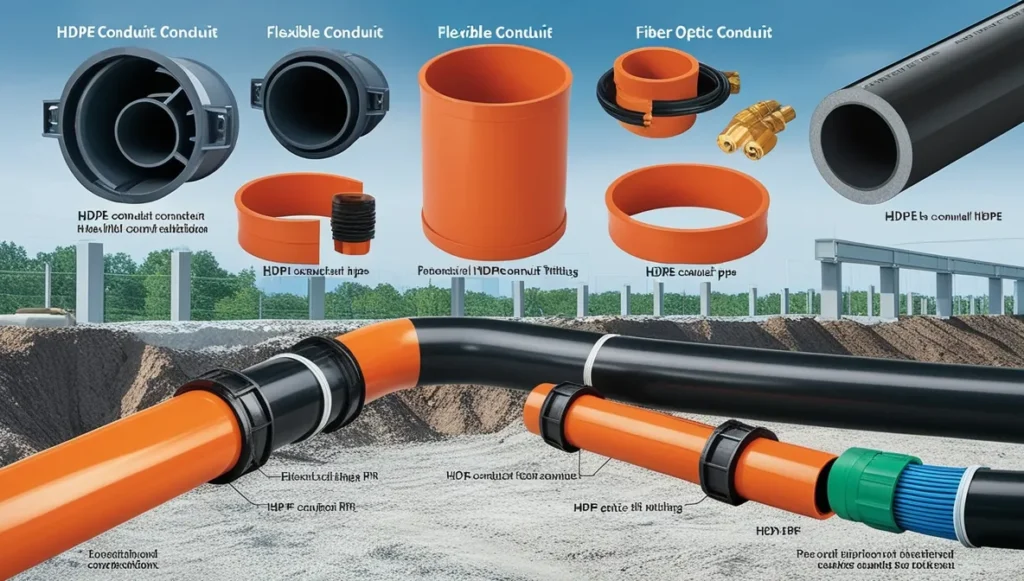High-Density Polyethylene (HDPE) conduit is revolutionizing the way electrical and communication systems are installed and maintained. Whether you’re a professional contractor, electrician, or a homeowner looking to enhance your property’s electrical systems, understanding HDPE electrical conduit, its fittings, and its versatile uses is crucial. In this article, we will explore the types, benefits, applications, and installation tips for HDPE conduit. Let’s dive in!
What is HDPE Conduit?
HDPE conduit refers to a flexible and durable piping system made from high-density polyethylene. It is commonly used to protect electrical wires and fiber optic cables in underground and exposed installations. Its exceptional resistance to chemicals, water, and environmental stress makes it a preferred choice for various applications in the USA and UK.
Types of HDPE Conduit
1. HDPE Electrical Conduit
This type of conduit is specifically designed to house and protect electrical wiring in residential, commercial, and industrial applications. It’s lightweight yet robust, making installation quick and efficient.
2. HDPE Flexible Conduit
The flexible variant is ideal for projects that require bending around corners or fitting into irregular spaces. Its flexibility ensures seamless installations, particularly in challenging terrains.
3. HDPE Fiber Optic Conduit
HDPE fiber optic conduit is engineered to safeguard fiber optic cables, ensuring consistent and uninterrupted communication networks. Its smooth interior minimizes friction during cable installation.
| Type of HDPE Conduit | Key Features | Common Applications |
|---|---|---|
| HDPE Electrical Conduit | Rigid and durable | Electrical wiring protection |
| HDPE Flexible Conduit | Bendable, easy to install | Tight or irregular spaces |
| HDPE Fiber Optic Conduit | Smooth interior, durable | Communication and data cabling |
Also Read: How to Cut HDPE Sheets
Key Benefits of HDPE Conduit
1. Durability
HDPE conduit pipes are resistant to physical damage, corrosion, and chemical reactions. This ensures long-term performance, even in harsh environments.
2. Cost-Effectiveness
Despite its superior quality, HDPE conduit is cost-efficient. Its lightweight nature reduces transportation costs, while its durability minimizes maintenance expenses.
3. Flexibility
HDPE conduit fittings are designed for easy installation. Flexible options allow for streamlined routing through tight spaces or around obstacles.
4. UV Resistance
HDPE electrical conduit fittings are UV-stabilized, ensuring they can be used in outdoor applications without degrading over time.
5. Environmental Friendliness
HDPE is recyclable and requires less energy for production compared to other materials, making it a sustainable choice for the environmentally conscious.
Applications of HDPE Conduit in the USA and UK
1. Electrical Installations
HDPE electrical conduit and fittings are widely used for both residential and industrial wiring systems, offering robust protection against environmental factors.
2. Telecommunications
The use of HDPE fiber optic conduit is prevalent in data transmission and broadband infrastructure projects.
3. Renewable Energy Projects
HDPE conduit pipes are extensively used in solar and wind power systems for routing cables efficiently.
4. Underground Installations
HDPE flexible conduit excels in underground utility systems due to its ability to resist water, chemicals, and soil pressure.
5. Roadway and Transportation
In the USA and UK, HDPE conduit is used to protect cables in smart road systems and transportation projects.
HDPE Conduit Installation Tips
- Choose the Right Type: Select the appropriate HDPE conduit based on the specific application (e.g., electrical, fiber optic, flexible needs).
- Use Compatible Fittings: Ensure HDPE conduit fittings match the pipe diameter and type for a secure fit.
- Follow Local Codes: Adhere to the building and safety regulations in your region.
- Avoid Overheating: Use proper tools for heat fusion to connect HDPE conduit pipes without compromising their integrity.
- Inspect Regularly: After installation, inspect the system for any potential weaknesses or misalignments.
Comparison: HDPE Conduit vs. Other Materials
| Material | Durability | Flexibility | Cost | Common Applications |
|---|---|---|---|---|
| HDPE | High | Excellent | Affordable | Electrical, telecom, utilities |
| PVC | Moderate | Limited | Low | Indoor wiring |
| Steel Conduit | Very High | Minimal | Expensive | Industrial, heavy-duty needs |
HDPE Conduit FAQs
1. What is HDPE electrical conduit used for?
HDPE electrical conduit is primarily used to house and protect electrical wiring systems in residential, commercial, and industrial settings.
2. Can HDPE conduit be used above ground?
Yes, HDPE conduit can be used above ground as it is UV-resistant and can withstand environmental exposure.
3. What are HDPE conduit fittings?
HDPE conduit fittings are accessories designed to connect or secure HDPE conduit pipes. Common fittings include couplers, bends, and end caps.
4. Why is HDPE flexible conduit preferred for underground installations?
HDPE flexible conduit is preferred for underground installations due to its resistance to water, chemicals, and soil pressure, as well as its ability to bend around obstacles.
5. Is HDPE conduit recyclable?
Yes, HDPE conduit is recyclable, making it an environmentally friendly option.
Conclusion
HDPE conduit stands out as a versatile, durable, and cost-effective solution for a wide range of electrical and communication applications. From HDPE electrical conduit to HDPE fiber optic conduit, the options are extensive and cater to diverse needs in the USA and UK markets. By choosing the right type of conduit and fittings, you can ensure a reliable and efficient system that meets modern standards.
With its growing popularity across industries, HDPE conduit is set to remain a cornerstone of infrastructure projects. Whether you’re upgrading your property or working on a large-scale installation, HDPE conduit offers the reliability and sustainability needed for today’s challenges.
